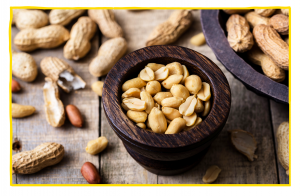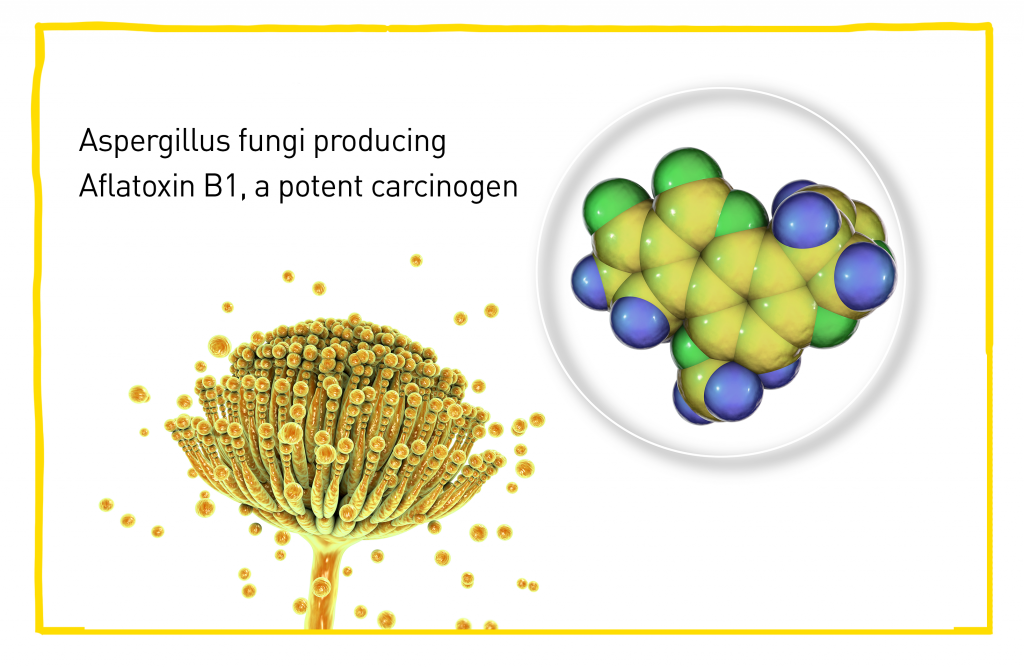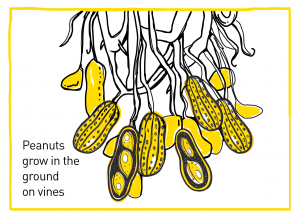An Everyday DNA blog article
Written by: Sarah Sharman, PhD, Science writer
Illustrated by: Cathleen Shaw
 Peanuts. You can eat them boiled and roasted, as peanut butters and oils. They are a common add-in to many chocolate candies and desserts. Internationally, peanuts also serve as an important protein source in many diets, forming the base for sauces, soups, and chutneys.
Peanuts. You can eat them boiled and roasted, as peanut butters and oils. They are a common add-in to many chocolate candies and desserts. Internationally, peanuts also serve as an important protein source in many diets, forming the base for sauces, soups, and chutneys.
As much as we rely on peanuts as a source of food and nutrients, peanut farmers rely on them just as much for their livelihood. In order to make the most profit per acre of land, farmers must plant and harvest a maximum number of peanuts. A successful harvest is heavily reliant on a number of environmental factors like pests, fungi, toxins, and weather events such as drought, heavy periods of rain or late freezes. Let’s learn about an especially troublesome and dangerous peanut foe called aflatoxins.
What are aflatoxins?
Aflatoxins are poisonous substances produced by certain fungi that are naturally found on agricultural crops like peanuts, tree nuts, maize, and grains. They were discovered in England in 1960 when more than 100,000 young turkeys died from an apparently new disease called “Turkey-X disease”. Scientists studying the outbreak soon discovered that the disease was associated with Brazilian peanut meal that the turkeys had been fed. Further studies found a toxin in the peanut meal that originated from the fungus Aspergillus flavus.
The name “aflatoxin” was born by virtue of its origin from Aspergillus flavus. Another fungus, called Aspergillus parasiticus, is also a major producer of aflatoxins. Both fungi are abundant in warm and humid regions of the world. The aflatoxin-producing fungi can contaminate crops in the field, during harvest, or during transport and storage. Drought, pests, delayed harvest, insufficient drying of crops, and poor post-harvest handling can all cause the production of higher levels of aflatoxins.
Aflatoxins are potent carcinogens, meaning they can cause cancer. In fact, one type of aflatoxin called B1 is considered the most potent naturally occurring carcinogen by physicians and toxicologists. The liver is the main organ targeted by aflatoxins.
Long-term exposure to low doses of aflatoxins leads to serious health consequences like liver cancer and severe damage to the liver, also called hepatotoxicity. Other symptoms of aflatoxin exposure include immune suppression, impaired growth, organ failure, impaired nutrient absorption, and low birth rate. Large doses of aflatoxin can cause life threatening, acute poisoning called aflatoxicosis. Children are especially susceptible to aflatoxin exposure, suffering from stunted growth, delayed development, liver damage, and even liver cancer.
Exposures can occur in humans and animals that eat or come into close contact with the toxins. For example, farmers can be exposed to aflatoxins by inhaling dust generated during the handling and processing of contaminated crops and feeds. Consumers are exposed to aflatoxins by eating contaminated plant products or meat or dairy products from animals that ate contaminated feed.
Detecting aflatoxin exposure in humans and animals is important in investigating suspected aflatoxin contamination outbreaks. There are two techniques commonly used to detect exposure in humans. One measures a molecule present in urine up to 24 hours after exposure, while the second measures the levels of a compound in the blood serum days to weeks after exposure.
How is aflatoxin exposure controlled?
Due to their highly carcinogenic nature, exposure to aflatoxins should be kept as low as possible. Many countries have regulations defining acceptable limits of aflatoxins in different foodstuffs. For example, the United States FDA sets the action levels for aflatoxin presence in food. Commercial crops are routinely screened for aflatoxin using detection techniques that are performed in a laboratory setting. Food products exceeding the limits are recalled and destroyed as a precautionary measure to prevent exposure.

In developing nations, however, many people are exposed to aflatoxin through food grown at home. Inadequate harvesting and storage techniques allow for the growth of aflatoxin-producing fungus. Many developing nations do not have defined limits for aflatoxin presence and homegrown crops are not routinely tested. An estimated 4.5 billion people living in developing countries may be chronically exposed to aflatoxin through their diet.
The loss of crops is only one of the negative impacts of aflatoxins on the global economy. High medical costs and toxic effects on livestock due to aflatoxin exposures also devastate economies. Mitigating losses from aflatoxins, while also ensuring consumers are protected from contamination, is a delicate balance scientists and farmers are continually trying to achieve.
How are scientists working to combat aflatoxins?
Because crops can be contaminated with aflatoxins at any point during their lifecycle, control measures are required both pre- and post-harvest. The most effective, long-term solution to controlling pre-harvest aflatoxin contamination is through creating crops that can resist infection by the aflatoxin-producing fungi or prevent the fungi from producing the aflatoxins. This can be achieved through directed plant breeding genetic engineering of such resistant crops.
 Interventions for preventing contamination after harvest include addressing adequate storage conditions such as proper moisture, temperature, and aeration, and avoiding excess mechanical and insect damage. Aflatoxins can be removed from contaminated foodstuffs using chemical decontamination or compounds called enterosorbents.
Interventions for preventing contamination after harvest include addressing adequate storage conditions such as proper moisture, temperature, and aeration, and avoiding excess mechanical and insect damage. Aflatoxins can be removed from contaminated foodstuffs using chemical decontamination or compounds called enterosorbents.
At the HudsonAlpha Institute for Biotechnology, Josh Clevenger, PhD, and his lab are focused on identifying targets to mitigate aflatoxin-related crop loss and human exposure to aflatoxin. In the southern United States, peanuts are grown without water irrigation, relying on rainfall alone to water the crop. When conditions are hot and dry, aflatoxin-producing fungi will produce aflatoxin as a response to drought stress. Clevenger and his team think that increasing drought tolerance in peanuts can alleviate the drought stress on the developing seed and eliminate aflatoxin contamination.
The team are using genomics, as well as new computational technologies and breeding methods, to produce and deploy varieties of peanut that are both drought tolerant and resistant to aflatoxin. To do this, Clevenger and his team identify genetic sources of drought tolerance and low aflatoxin contamination, identify candidate variation that can be used to select for those traits, and integrate and validate those factors in valuable peanut varieties. The ultimate goal is to work towards providing genetic tools for breeders all over the world to deploy varieties that can maintain yield under drought stress and mitigate aflatoxin contamination.


